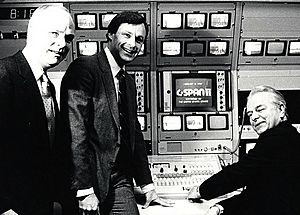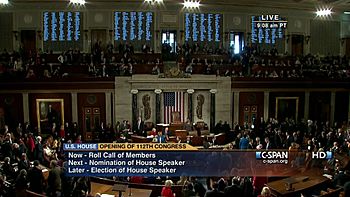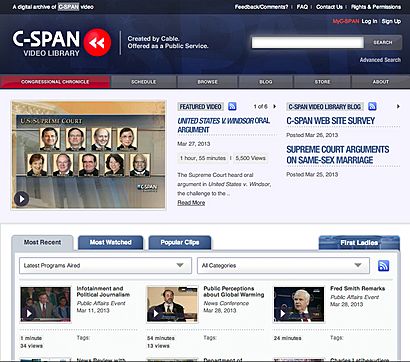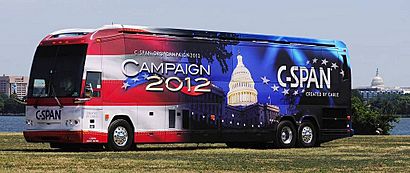C-SPAN facts for kids
| Country | United States |
|---|---|
| Broadcast area | Worldwide |
| Headquarters | Capitol Hill, Washington, D.C. |
| Programming | |
| Language(s) | English |
| Picture format | 1080i (HDTV) (downscaled to letterboxed 480i for SDTV feeds) |
| Ownership | |
| Owner | National Cable Satellite Corporation |
| Sister channels | C-SPAN2 C-SPAN3 C-SPAN Radio |
| History | |
| Launched | March 19, 1979 (C-SPAN) June 2, 1986 (C-SPAN2) January 22, 2001 (C-SPAN3) |
| Founder | Brian Lamb |
| Availability | |
| Terrestrial | |
| WCSP-FM/HD (C-SPAN Radio) |
FM 90.1 MHz analog/HD Radio (Washington, D.C. / Baltimore) |
| Selective TV, Inc. (Alexandria, Minnesota) |
K33DB-D 50.3 |
| Streaming media | |
| Available only to current cable/satellite subscribers | C-SPAN Live and on demand |
C-SPAN stands for Cable-Satellite Public Affairs Network. It is an American TV network that shows what happens in the U.S. government and other public events. C-SPAN started in 1979. It was created by the cable TV industry as a non-profit service. This means it doesn't try to make money for owners.
C-SPAN is a private, non-profit group. It gets its money from cable and satellite TV companies. You won't see commercials on its TV channels or radio stations. The network works on its own. Neither the cable industry nor the U.S. Congress tells C-SPAN what to show.
The C-SPAN network has three main TV channels:
- C-SPAN: This channel mostly shows what happens in the U.S. House of Representatives.
- C-SPAN2: This channel focuses on the U.S. Senate.
- C-SPAN3: This channel broadcasts other government meetings and related programs.
C-SPAN also has a radio station called WCSP-FM and several websites. These websites let you watch live videos and old programs. C-SPAN's TV channels are available in about 100 million homes in the United States.
The network shows U.S. political events. This includes live coverage of the U.S. Congress. It also covers other big events around the world. C-SPAN shows these events without adding comments or opinions. This helps viewers get information directly. Besides politics, C-SPAN also shows historical programs, non-fiction book discussions, and interviews with important people.
Contents
How C-SPAN Started and Grew
Early Days of C-SPAN

Brian Lamb thought of the idea for C-SPAN in 1975. He was working for a magazine about cable TV. Lamb imagined a non-profit network that would show Congress and public events. This network would be paid for by the cable TV companies.
C-SPAN officially started on March 19, 1979. It began with the first televised session of the House of Representatives. At that time, only 3.5 million homes could watch C-SPAN. The network had only three employees. For the first few years, C-SPAN shared satellite time with another network. It broadcast about 9 hours a day. By February 1982, C-SPAN had its own satellite space. It then broadcast 16 hours a day. C-SPAN started broadcasting all day, every day, on September 13, 1982.
Adding More Channels
C-SPAN2 launched on June 2, 1986. It was created to cover the Senate. It started broadcasting all day on January 5, 1987. The Senate had discussed allowing TV cameras for over two years before this happened.
In 1992, a new rule made it harder for some cable companies to carry C-SPAN. This meant some areas lost C-SPAN or C-SPAN2. People protested these changes. Eventually, technology improved, and C-SPAN became widely available again.
C-SPAN3 began broadcasting all day on January 22, 2001. It shows public policy events and government meetings on weekdays. On nights and weekends, it airs historical programs. C-SPAN3 also acts as an extra channel when C-SPAN or C-SPAN2 have too many live events. C-SPAN Radio also started in 1997. It covers similar events as the TV channels.
In 2010, C-SPAN started changing to high-definition (HD) TV. C-SPAN and C-SPAN2 became available in HD in June 2010. C-SPAN3 followed in July 2010.
In 2012, Brian Lamb became the executive chairman. Susan Swain and Robert Kennedy became co-CEOs. In 2024, Sam Feist became the new CEO. Brian Lamb retired in 2024, and Patrick J. Esser became the new chairman.
C-SPAN Online
In January 1997, C-SPAN started showing live streams of C-SPAN and C-SPAN2 on its website. C-span.org also shows live programs like committee hearings and speeches. These are often broadcast later on TV.
On January 12, 2017, the C-SPAN1 online feed was briefly replaced by another network's feed. C-SPAN said it was likely an internal technical problem.
Camera Access in Congress
C-SPAN broadcasts video from the House and Senate floors. However, C-SPAN does not control where the cameras are placed or how many there are. Arguments about C-SPAN's cameras started as early as 1984. At first, C-SPAN only showed the person speaking. This led to some funny moments, like when a politician gave a speech to an empty room.
After 1984, the House allowed both wide-angle shots and close-ups. But in 1994, they went back to just close-ups. The Senate, which allowed cameras since 1987, always used only close-ups.
C-SPAN has asked many times to bring its own cameras into Congress. They wanted to show wider shots and have their own employees control the cameras. These requests have always been turned down.
In June 2016, C-SPAN showed video from House members' phones. This happened during a sit-in about gun control. The official House cameras could not be used because the House was not in session. C-SPAN noted that these phone streams broke House rules.
In January 2023, C-SPAN got a lot of attention for its broadcast of the Speaker of the House vote. Because the House was not in session, C-SPAN was allowed to use its own cameras. This let them show new angles of the House floor. After the Speaker was chosen, the camera rules went back to normal.
What C-SPAN Shows
Focus on Congress
The main thing C-SPAN shows is live coverage of the U.S. House and Senate. C-SPAN focuses on the House, and C-SPAN2 focuses on the Senate. This allows viewers to follow new laws as they move through Congress. C-SPAN has covered many important debates, like the Gulf War in 1991 and the impeachment trials of Presidents Bill Clinton and Donald Trump. When the House or Senate are not meeting, C-SPAN channels show other public affairs programs or recordings of past events.
Public Affairs Programs
C-SPAN's public affairs coverage is very broad. It is seen as a good source of information for journalists, teachers, and anyone interested in politics. C-SPAN shows political events without editing them. This gives viewers a direct look at how politics and government work.
C-SPAN covers U.S. political campaigns, including the big party conventions. It also has a weekly TV show called Road to the White House. This show follows presidential campaigns.

All three channels show events like congressional hearings, White House press briefings, and presidential speeches. They also cover other government meetings. C-SPAN aims to be fair and unbiased. Its hosts do not share their opinions. They just help explain what is happening.
Sometimes, C-SPAN shows events from other countries' governments, like the Parliament of the United Kingdom. This happens when those events are important to U.S. viewers. C-SPAN also broadcasts news from around the world during major events. For example, it showed coverage of the September 11 attacks. It also shows NASA Space Shuttle launches and landings.
Main C-SPAN Programs
C-SPAN's day starts with Washington Journal. This is a live phone-in and interview show. It airs every morning from 7:00 to 10:00 a.m. Eastern Time. Guests include politicians, government officials, and journalists. Viewers can call in and ask questions.
On weekend evenings, C-SPAN has Q&A. This is an interview show hosted by Peter Slen. Guests include journalists, politicians, and authors.
On weekends, C-SPAN2 dedicates its schedule to Book TV. This is 48 hours of programs about non-fiction books, book events, and authors. Book TV started in September 1998. It includes programs like In Depth, which is a long interview with one author. Another show is After Words, where guest hosts interview authors. Book TV also covers book fairs and author readings.
C-SPAN3 Programs
C-SPAN3 shows public affairs events, congressional hearings, and history programs. On weekdays, it has live public affairs events from Washington, D.C. Every weekend, C-SPAN3 broadcasts 48 hours of programs about U.S. history. This is called American History TV. These programs cover U.S. history from the country's beginning to the late 20th century. Shows include American Artifacts, which explores museums and historical sites. Lectures in History features university professors giving talks on U.S. history.
Special Programs
C-SPAN has also made special series and documentaries. For its 15th anniversary, Booknotes helped create reenactments of the 1858 Lincoln–Douglas debates. The series American Presidents: Life Portraits won an award. It was made for C-SPAN's 20th anniversary.
In 2015, C-SPAN started Landmark Cases: Historic Supreme Court Decisions. This series was about important cases decided by the United States Supreme Court. A second season aired in 2018.
First Ladies: Influence & Image, a series about American First Ladies, started in 2013. A book based on the series was published in 2015.
Radio and Online Access
C-SPAN also broadcasts on C-SPAN Radio. This is on WCSP-FM (90.1 FM) in Washington, D.C. It is also available nationwide on XM Satellite Radio. You can also listen live on c-span.org and through apps on phones. C-SPAN Radio does not just copy the TV channels. It also has unique programs like oral histories and some meetings not shown on TV.
All C-SPAN programs since 1987 are available in the C-SPAN Video Library. This library is a huge collection of videos. It has over 271,000 hours of programming. It has been viewed over 253 million times. The C-SPAN Video Library is a great resource for students and researchers. It won an award in 2010 for being a free and easy-to-use public service.
In 2007, C-SPAN changed its copyright policy. It now allows people to copy, share, and post its videos of official government events online for non-commercial use. This means you can use C-SPAN videos for school projects or to share information, as long as you say where they came from and don't sell them.
In 2014, C-SPAN started requiring a cable or satellite subscription to watch the live feeds of its main channels online. However, all government meetings, hearings, and conferences can still be streamed live or watched later for free. Live audio feeds are also free on the mobile app.
How C-SPAN Works
| Founded at | Washington, D.C. |
|---|---|
| Type | Nonprofit |
| Legal status | 501c3 |
| Purpose | Public affairs broadcasting |
| Location |
|
|
Region served
|
United States of America |
|
Key people
|
|
|
Main organ
|
C-SPAN |
|
Revenue (2023)
|
|
| Expenses (2023) | |
|
Staff (2023)
|
198 |
C-SPAN is run by the National Cable Satellite Corporation. This is a non-profit organization. C-SPAN gets most of its money from fees paid by cable and satellite TV companies. In 2012, C-SPAN received about 6 cents from each subscriber's cable bill. This gave it an annual budget of about $60 million.
C-SPAN is an independent group. This means that neither the cable industry nor Congress controls what programs C-SPAN shows.
As of 2013, C-SPAN had between 282 and 337 employees. Most of C-SPAN's employees work at its headquarters in Washington, D.C. It also has studios in New York City and Denver, Colorado. C-SPAN also keeps its video archives in West Lafayette, Indiana.
Who Watches C-SPAN?
The C-SPAN networks are available in over 100 million homes. This does not include people who watch on the C-SPAN websites. C-SPAN does not use Nielsen ratings, so there are no official viewing numbers. However, surveys give us some ideas:
- A 1994 survey found that 8.6% of the U.S. population watched C-SPAN regularly.
- In 2004, this number grew to 12% of the U.S. population. Another 31% watched sometimes.
- A 2009 survey found that 20% of homes with cable TV watched C-SPAN at least once a week. This was about 39 million Americans.
- A 2013 survey showed that 47 million adults, or 24% of adults with cable TV, watched C-SPAN weekly.
- In 2017, a survey found that 70 million adults, or 36% of adults with cable TV, watched C-SPAN over a six-month period.
Public Opinion of C-SPAN
C-SPAN is often praised for helping people learn about their government. Many people see it as a valuable service. It gives public access to important events. C-SPAN is also noted for providing this service without federal funding or commercials.
The Washington Post noted that C-SPAN's programs have been copied by TV networks around the world. It also said C-SPAN helps Americans learn about politics in other countries. The New York Times called C-SPAN "one of a kind" because it records official events in Washington, D.C. The C-SPAN Video Library is especially important.
C-SPAN tries to be neutral and unbiased. However, some groups have said that C-SPAN's shows have a conservative bias. A 2005 study looked at C-SPAN's Washington Journal show. It found more "right-of-center" guests than "left-of-center" guests.
Other C-SPAN Services
C-SPAN offers other services to the public. C-SPAN Classroom is a free service for teachers. It helps them use C-SPAN resources in their classes.
The C-SPAN School Bus started in 1993. It traveled around the U.S. to teach people about government and politics. The bus also recorded videos of the places it visited. The original buses were replaced in 2010 by the C-SPAN Digital Bus. C-SPAN also has Local Content Vehicles (LCVs). These vehicles travel the country to record unique political and historical stories.
C-SPAN has published ten books based on its programs. These books include original material and text from interviews. Some titles are C-SPAN: America's Town Hall and Gavel to Gavel: A C-SPAN Guide to Congress. Other books are about U.S. presidents and the Supreme Court. Five books came from the Booknotes program.
See also
 In Spanish: C-SPAN para niños
In Spanish: C-SPAN para niños
- Public, educational, and government access



